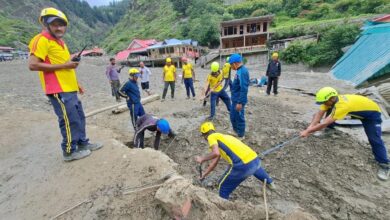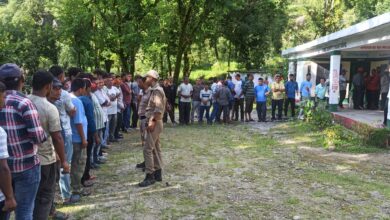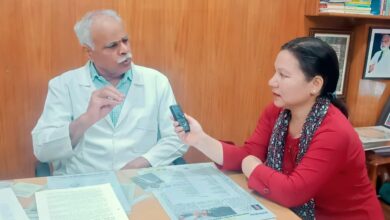Katal Village: Now we throw away the bark of Bhimal, earlier we used it a lot
Exploring Katal Village: Silk Farming, Bhimal Trees, and Rural Challenges
Rajesh Pandey, Dehradun
I only knew that Katal Village was famous for silkworm farming. However, I had never been there before. Last Sunday (20 April 2025), when I finally visited, I discovered that the area also has an abundance of Bhimal trees. Bhimal is valuable for both livestock rearing and commercial purposes in the hills. However, during conversations throughout the village journey, I learned that the traditional use of Bhimal bark fibers is no longer given much importance.
I often get the opportunity to explore villages along with village travelers Mohit Uniyal and Anand Manwal, and travel photographer Sarthak Pandey. Mohit and Anand are advocates of social issues and organize village journeys to connect with local people.
Watch – Video of Katal Village Journey
How to Reach Katal Village
On Sunday morning, we decided to visit Katal Village, which is about 25 km from Dehradun. To get there, you first head towards Thano and then take the Bhogpur road, turning towards the Home Guard Training Institute after about half a kilometer. After passing the institute, the road slopes downhill. The road is paved and decent. From here, you can see the beautiful view of the Vidhalna River and the surrounding Talai fields and houses.
After crossing the downhill section, you will see a bridge to Sindhwal Village on the left, but do not cross the bridge; instead, continue straight.
We continued straight, without crossing the bridge that leads to Sindhwal Village, Nahinkala, and Dhaksari. Our destination was Katal.
In the rainy season, reaching Katal Village becomes challenging due to the seasonal streams. In summer, these streams don’t have much water. There’s an old irrigation canal here, similar to the Bhogpur canal. We also learned that there used to be a water mill (gharhat), which no longer exists. We saw old suspension bridges (jhoola pul), suggesting that these streams used to be very wide earlier.
Walking along the forest edge and streams, we finally reached the point where we had to start climbing towards Katal Village. From the Sindhwal bridge, the road ahead is rough and filled with river stones and sand, requiring careful driving, but we had to walk only about 1.5–2 km.
The View of Dharkot Road from Katal
From a point on the trail, a house of Katal Village was visible. In front of us, we could see the road leading from Thano to Dharkot and onward to Baderna. Dharkot is a beautiful area connected to many villages like Upper Talai, Haldwadi, Ladwakot, Baderna, Paled, Akhandvani Bhilang, Jamankhal, and Soda Saroli, eventually leading back to Dehradun. Some of these routes are still dirt roads, but road networks are expanding steadily.
Bhimal Branches in the Stream
Manwal informed us that the stream we were crossing is called Gwadi Khala, confirmed by a nearby government signboard. It flows from Dharkot. We crossed a very old cement bridge, a bit cautiously, although it wasn’t too dangerous.
Under the bridge, we saw branches submerged in water—these were Bhimal branches, locally called Bhimal ke Kede.
Bhimal Fibers – A Source of Income
Bhimal is considered a great support for animal husbandry and the economy in the hills. Manwal explained that Bhimal’s bark is processed into fiber. Mohit Uniyal mentioned that near Rishikesh, at Dhalawala, the Indian Rural Upliftment Institute has trained villagers to make baskets, slippers, and decorative items from Bhimal fibers, helping them achieve self-employment.
Manwal added that the Bhimal branches (kede) are also used for fuel. Their bark peels off easily after soaking in water and can be used to produce fibers.
The Trek to Katal Village
We decided to talk about Bhimal with the villagers. After a steep half-kilometer climb on a trail scattered with slippery stones, we reached a house in Katal Village.
Climbing uphill while carrying equipment was not easy, especially for Sarthak, who was carrying a camera and gimbal weighing over 1.5 kg. Walking carefully on mountain trails with such weight was a big challenge for us city-dwellers.
Stone Slab Roofs – Marvels of Old Engineering
During the climb, Mohit pointed out that the old houses had roofs made of large stone slabs (Patals). It was a marvel of traditional engineering, setting each stone so securely that even storms and rains couldn’t displace them. Modern cement and tin roofs do not match this craftsmanship.
Trekking Challenges in Mountain Villages
As we climbed, I found myself out of breath. However, this trek wasn’t as strenuous as others we had done in places like Upper Talai, Chittoor, Haldwadi, Ragad village, and more.
Farming and the Problem of Wild Animals
In Katal Village, we saw houses scattered far apart and many empty fields. Local resident Hukam Singh explained that wheat was not grown because wild animals like monkeys, langurs, and wild boars destroy the crops.
This is a common issue across hill villages: much of the farmland lies abandoned, making the remaining cultivated areas prime targets for wild animals.
Earlier, when entire villages farmed actively and livestock grazing was common, wild animals stayed away. Now, with reduced human activity, animals have become bolder, even entering courtyards.
Plans for Paddy and Turmeric Cultivation
Hukam Singh shared that while the fields had been left fallow during the wheat season, they planned to sow paddy and turmeric in the upcoming season. He acknowledged that many villagers had left for urban jobs, leaving behind insufficient manpower for farming.
“Meri Pyari Boi” and the Pain of Migration
While chatting, Mohit mentioned the Garhwali film “Meri Pyari Boi,” originally made in 2004, re-released after 21 years. The film highlights the struggles of mountain life and the pain of migration. One dialogue—”As long as the hearth burns, the land stays alive”—struck a deep chord, symbolizing how abandonment leads to the death of villages.
Mohit pointed out that better education, healthcare, employment, and infrastructure are essential to curb migration from the hills.
The Warm Hospitality at Katal Village
We finally reached the house with a cattle shed. Bhimal branches, jackfruit, mulberry, and Bhimal trees surrounded the home. The mulberry trees are vital for silkworm rearing as silkworms feed on their leaves.
Hukam Singh warmly welcomed us, offering cool water, hot tea, traditional sweets (Arse), savory snacks, and Mathri. I particularly enjoyed the Arse sweets.
Bhimal Everywhere, but Fibers Underutilized
Hukam Singh mentioned that the area, including Katal, Simiyand, and Kothar, has an abundance of Bhimal trees. Earlier, villagers made ropes, baskets, and churn ropes from Bhimal fibers. Now, due to forest department restrictions and migration, this traditional craft has declined.
Mohit suggested that if villagers form cooperatives, they could collectively harvest Bhimal fibers and market products made from them, creating a sustainable source of income. Hukam Singh agreed that if there is a market, work could be restarted.
Biogas Plants and Energy Alternatives
There was also a biogas plant in the village, used mainly for cooking rice, lentils, and vegetables, although not for baking chapatis, due to the smell.
Discovery of a Jeep Route
While returning, we learned there was an alternate rough road that four-wheelers could use to reach the village. Arun, a local youth, owns a jeep and mentioned that preparations for the Char Dham Yatra are ongoing, which is a big opportunity for local drivers.
We walked back along the broad dirt road to our parked vehicle near Gwadi Khala, stopping to enjoy the flowing water and the natural beauty for a while.




